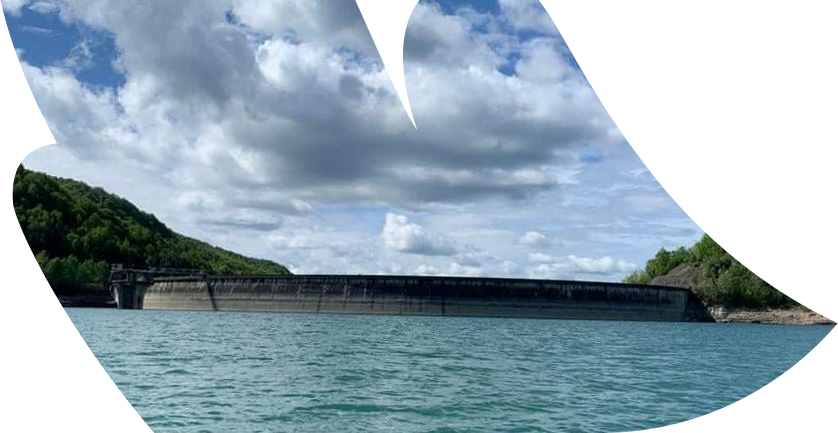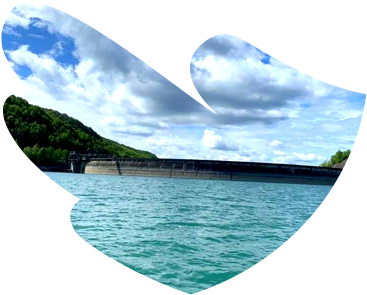Who manages the flood risk
The flood risk management requires a series of technical specialized knowledge. It requires multidisciplinary combined expertise of a high number of specialists, starting with civil engineers and hydrologists, as well as specialists in biodiversity, economy, communication. Which are the Romanian authorities with such an expertise?


At national level, the main public institutions in charge with the flood risk management are the Ministry of Environment, Waters and Forests (MEWF) and the „Romanian Waters” National Administration (ANAR), together with its subordinated institutions (the National Institute of Hydrology and Water Management and the 11 River Basin Administrations).
MEWF develops national policies for water management, safety of constructions and of hydrotechnical facilities, has key responsibilities in the water and environmental sector and defines all relevant public policies. ANAR is under the coordination of the central public authority in the water sector – MEWF, it manages the waters from the public domain of the State, as well as the National Water Management System infrastructure.
In addition to these two public institutions, it is necessary to engage a high number of stakeholders and to establish decision-making and emergency coordination mechanisms and procedures. All these stakeholders and their roles are regulated in the National Strategy for the Flood Risk Management.
What is your role?
Did you know that citizens have a role, as well as responsibilities related to floods? Any Romanian inhabitant can inform himself/herself and become prepared for those situations where he/she might be caught up in a flood, regardless of whether the respective person lives or not in an area with a significant flood risk. You can get informed, but you can also become involved as a volunteer in actions for rescuing or evacuating the population affected by floods, as well as in recovery actions in the affected areas. Besides, you can also acquire an insurance covering your house and assets in case of flooding.
Or you can just be prepared. Just read the guide!

Role of Central Public Authorities
The Ministry of Environment, Waters and Forests
The Ministry of Environment, Waters and Forests (MEWF) is the central public authority in charge with the flood risk management. MEWF prepares the strategy and regulations proper to activities for application of the strategy within the general policy of the Government, ensures and coordinates the application of the Government strategy in its areas of competence, having the role of state authority, responsible for the summarization, coordination, regulation, monitoring, inspection and control in such areas.
Each central public authority plays an important role in the flood risk management. The responsibilities and role of each of them are set forth by law and can be found with details in the National Strategy for the Flood Risk Management. You will find below examples of some of these roles, as well as the responsible central public authorities:

The Ministry of Agriculture and Rural Development (MARD) provides the funds for agricultural land zoning, introduction of sustainable agricultural practices, identification of areas prone to the risk of soil erosion and measures for controlling such a risk, keeping in a proper operational state the drainage and dessication systems, as well as flood protection measures etc.
Ministerul Afacerilor Interne (MAI) asigură conducerea Comitetului Național pentru Situații de Urgență (CNSU), coordonează activitatea instituțiilor prefectului care asigură managementul riscului la inundații la nivel de județ, comunicarea către populație a pagubelor produse de pentru diminuarea acestora etc.
The Ministry of Transports and Infrastructure (MTI) ensures the provision of information on the infrastructure necessary for development of the River Basin Master Plan and of Flood Risk Management Plans, conducting studies and projects on the floodability of national roads and railways, reassessing the condition of bridges and culverts and related repair works, where required etc.
The Ministry of Development, Public Works and Administration (MDPWA).
The main responsibility of MDPWA in terms of flood risk management refers to the preparation and harmonization of norms on inhabited areas, including flood risk-prone areas.
The Inter-ministerial Committee on Water
The Inter-ministerial Committee on Water coordinates and endorses policies and strategies for water resources management and flood risk management, in order to shape an integrated and sustainable approach. Moreover, the Committee sets the priorities and makes proposals for allocation and mobilization of available financial resources, in order to achieve the intended goals. This Committee endorses action plans for water resources management and for flood protection, monitors their implementation, ensures the cooperation and facilitates the exchange of information among institutions in the process of implementing European Directives in the field of water management and flood risk management.

The Ministry of Health (MH) has a very important role both before, during and after the floods occur. MH is in charge with informing the population of the risks of getting sick during floods and of relevant preventive measures, by providing medical aid and the sanitary transportation for the population in the areas affected by floods, control of the drinking water quality, assessment of the health condition of affected communities and adoption of rehabilitation and recovery measures etc.

The Ministry of Education (ME) ensures the achievement of research and development projects related to the flood risk control, promotion and support for the implementation of projects and programs aimed at shaping and growing, in children and young people, a responsible attitude towards the flood risk etc.

The Ministry of Economy (ME) – aims at providing the funding for investment programs in order to develop hydro-energetic facilities with a role also in alleviating the flood waves.

The Ministry of Communications and Informational Society (MCIS) ensures the operation of communication connections necessary in emergency situations caused by floods.
The Ministry of Finance (MF) endorses the technical and economic indicators of feasibility studies concerning the flood risk management, conducted from public funds. MF develops economic mechanisms aimed at ensuring the necessary funds for improving the safe operating conditions of hydrotechnical constructions and facilities with a role in the flood risk control, as well as for developing new works.
Role of other institutions, authorities and trading companies
The „Romanian Waters” National Administration (ANAR) is the public institution managing, operating, maintaining and upgrading the National Water Management infrastructure. ANAR ensures the sustainable water resources management, applies strategies and policies in the water sector and takes flood protective measures through water management works under its coordination.
The National Institute of Hydrology and Water Management (INHGA) has the following responsibilities related to the flood risk management: the preparation of hydrologic forecast and issuance of hydrologic warning; involvement in the preparation of flood hazard and risk maps; development of guiding schemes for river basin arrangement and management, various other studies substantiating measures in the water management field.

The National Meteorological Administration (ANM). As regards the flood risk management, ANM has the following responsibilities: to ensure the monitoring of meteorological phenomena; to develop forecasts and issue meteorological warnings on various time intervals; to maintain web application for disseminating meteorological data and warnings, including mapping products on temperatures and rainfalls, radar images for the areas affected by dangerous phenomena, data from meteorological modeling etc.
The National Administration for Land Improvement (ANIF) is the main holder of desiccation facilities. It carries out many maintenance or operational activities both before, during and after flooding.
Societatea de Producere a Energiei Electrice în Hidrocentrale Hidroelectrica S.A. (SPEEH Hidroelectrica – S.A.) As the holder of the main national hydro-energetic facilities, most of which also with the role of alleviating or safely transiting flash floods, HIDROELECTRICA S.A. performs various preventive, operative or post-flood activities.
Compania Națională De Autostrăzi și Drumuri Naționale Din România – S.A. (the National Company for Road Infrastructure Administration)(C.N.A.D.N.R.) ensures the organization of interventions necessary for eliminating damages, restrictions or other situations caused by floods on national roads and on highways, as well as on related bridges; the design, building, modernization, rehabilitation, repair, maintenance and operation of roads of national interest, in order to have a safe road traffic under emergency situations caused by floods. In the case of emergency situations caused by floods, C.N.A.D.N.R. will act as soon as possible in order to restore the affected national road infrastructure.

The General Inspectorate for Emergency Situations (IGSU) ensures the permanent Technical Secretariat of the National Committee for Emergency Situations and carries out many key activities, especially for flood intervention, as well as for prevention and recovery of areas affected by flooding. Within IGSU, there is also the National Operational Center for Emergency Situations.
Inspectoratul de Stat în Construcții (the State Inspectorate for Constructions) (ISC) conducts various expert appraisals and provides technical endorsements for constructions in floodable areas, assesses the damages caused to constructions affected by floods, etc. ISC exerts the state control over the compliance with the key requirements for constructions which are erected in floodable areas; it exerts the state control over the compliance with the provisions of normatives applicable to thee conduct in urban and territorial planning.
River Basin Committees – The River Basin Committee is the main working body endorsing flood risk management plans, flood hazard maps and flood risk maps and ensures the public consultation of stakeholders and cooperates with the Ministerial Committee for Emergency Situations within the central public authority in the water sector, with the „Romanian Waters” National Administration and with other similar bodies, as applicable, in terms of flood protection plans and regulations.
Each river basin committee is made up of no more than 21 members appointed under the terms of the Water law and is chaired by a president and a vice-president, elected by open vote among the members for a 4-year office.
The full list of ANAR tasks related to the flood risk management, as well as of the other public institutions, authorities and of S.C. Hidroelectrica S.A. is to be found in the National Strategy for the Flood Risk Management.
Role of other bodies in the emergency management
National Level
Sistemul Național de Management al Situațiilor de Urgență – the National Emergency Management System (SNMSU). Created in 2004, it has the role of preventing and managing emergency situations, ensuring and coordinating human, material, financial and other kinds of resources necessary for restoring the normal post-emergency condition.
SNMSU is made up of:
- Committees for Emergency Situations
- The General Inspectorate for Emergency Situations
- Professional community public services for emergency situations
- Operational Centers for emergency situations
- The Operation Commander
At county and local level
Both the County Committee for Emergency Situations (CJSU), County Councils, the Local Committee for Emergency Situations (CLSU), Local Councils (municipality, town and commune councils) have competences and responsibilities related to the coordination of activities both before and during or after flooding.
Committee for Emergency Situations (CNSU). It operates under the coordination of MAI and under the leadership of the Prime Minister. It has competences related to the management of emergency situations caused by natural disasters, including flash floods and those related to accidents to the critical national infrastructure, as well as in case of regional disasters caused by flooding of certain localities or economic objectives. CNSU is responsible for the preparation of the strategy for integrated risk management and for setting up a national platform for the management of natural and anthropic risks.
Committee for Emergency Situations (CMSU) within the Ministry of Environment, Waters and Forests. CMSU has the following competences:
- to prepare the national strategy for flood risk management
- to coordinate the development of flood protection plans
- to address flood risk actions at international level
 Weather Warnings
Weather Warnings
